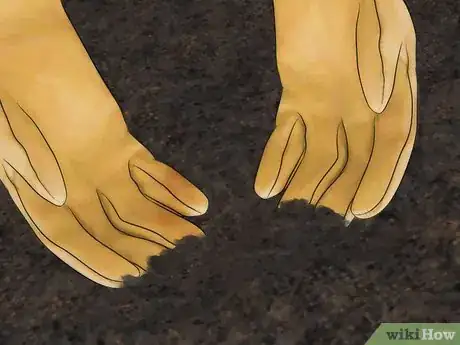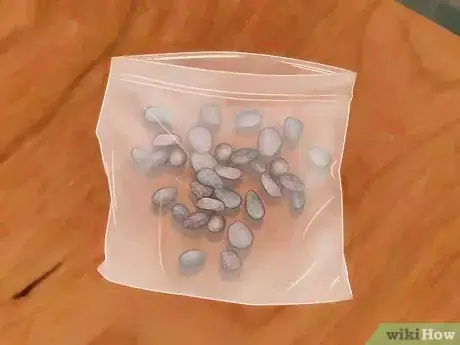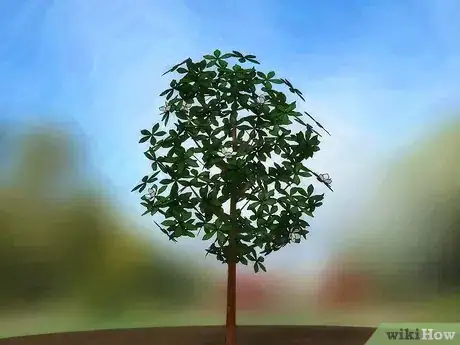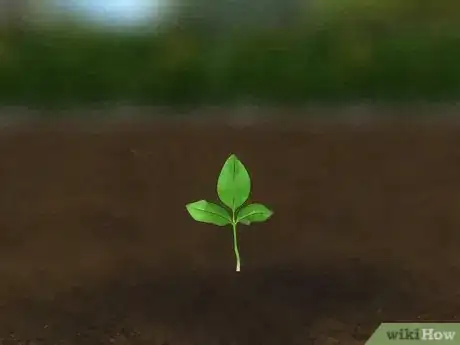This article was co-authored by One Tree Planted. One Tree Planted is a 501(c)(3) nonprofit on a mission to make it simple for anyone to help the environment by planting trees. Their projects span the globe and are done in partnership with local communities and knowledgeable experts to benefit nature, people, and wildlife. Since 2014, One Tree Planted has planted over 40 million trees across the globe.
There are 16 references cited in this article, which can be found at the bottom of the page.
This article has been viewed 98,985 times.
Magnolia trees are much-loved for their beauty. The flowers they produce are fragrant, and come in a range of vibrant colours. It is little wonder that many choose to grow magnolia trees in their gardens. Provided you have a suitable spot for the tree, you can create a beautiful centrepiece for your garden beginning with a seed. While growing a full tree takes time and patience, the end result is often more than worth the effort involved.
Steps
Laying the Seed
-
1Consider your climate. All plants have certain climates they prefer. Although magnolia trees tend to prefer temperate environments, they're quite adaptable and can tolerate hot summers with some drought. However, the potential for harsh weather conditions can make it trickier to make the tree thrive. "Plant hardiness" charts are available to refer to in this instance. They can offer a general indication of how appropriate your climate is for growing.[1]
- Some of the bigger magnolia trees will grow between 40-70 feet tall.[2]
- Certain magnolia trees are better suited to certain climates. Although magnolia trees are usually perfect for temperate weather, certain species like the Southern magnolia will suffer if the temperature drops below -5°C (23°F). This temperature issue can be lessened by planting the tree in an area where it won't get as much wind.
- You should keep the time of year in mind as well. Magnolia trees are best planted in the early spring. This will allow the trees to make the most of the seasonal changes in their first year of life.[3]
- The damages of harsh weather can be minimized by growing your tree somewhere where there is wind protection. Growing your tree in an enclosed area (like fenced housing) will help protect your tree during the most vulnerable years.
-
2Pick a spot with decent sun coverage. Magnolia trees favour getting full sun, but they can suffice with light shade as well. However, if you live in a particularly dry climate, it may actually benefit the tree to have a bit of moisture-saving shade.[4] Generally speaking, you'll want to find a place that gets at least some sun every day. The spot should also have enough room for a tree to grow to its full height naturally. This means keeping it away from potential obstructions, such as housing or low-hanging power lines.
- If you know your magnolia tree grows big (such as the Southern magnolia), do not grow it within six feet of a sidewalk or concrete foundation.[5] These larger magnolias will break through the concrete with their roots several years from now.
- Because growing a magnolia tree is a long-term effort, it's important to choose a spot where you'll have access for a number of years. This includes properties you own (as opposed to rent) and community gardens.
Advertisement -
3Ensure the soil is fertile enough. Magnolia trees prefer slightly acidic soil that's well-draining and contains lots of organic material. While none of this will be an issue if your area's climate is temperate and rainy enough, you can purchase high-fertility soil from a gardening store if there's a problem with your land.
-
4Collect some seed pods. Although magnolia seeds may be purchased from a store or ordered online, the seeds can also be gathered around magnolia trees. Some experts advise attracting them from the source because the seeds are no longer viable once they dry out.[8] Go to magnolia trees in September and October and look around the tree for seed pods to use in the spring. Alternatively, you may be able to find vendors who have gathered seeds locally and are willing to sell them. Here are some of the most common types of magnolia to consider:
- The Southern magnolia is a large tree that benefits from warm weather. It's one of the largest magnolia species and grows up to 80 feet.[9]
- The star magnolia grows to 15 feet and produces white flowers in the late winter. It is suited for colder environments.
- The Sweet Bay grows up to 50 feet and offers fragrant, white flowers and green leaves.
- If you're gathering seeds from a hybrid tree, the seeds won't necessarily grow to look exactly like the parent tree. You won't be able to tell exactly what kind of tree your seeds are growing into until they take bloom years later.
-
5Peel and scarify the seeds. When you have the seeds, peel off their outer shells.[10] Place them in a bowl of warm water overnight to soften them. Following that, you should also scarify the seeds by lightly scrubbing them with sandpaper or steel wool. This will make it easier for the seeds to take root when it comes time to plant them.
- Scarification refers to treating the seed's coat so that it's more susceptible to germination.
-
6Store seeds. If you collect them in September-October, you'll need to store them over the winter. To do this, dry them off, then seal them in a closed bag. Keep the bag safe until the early spring when it comes time to plant them. Keeping the seeds in a refrigerator or outdoors will help ensure they don't dry out.[11]
- Putting the seeds in water first helps to soften them for storing.
-
7Plant the seeds. After spending the winter in storage, it's finally time to plant the seeds. Dig open an area within the first top two inches of the soil and carefully deploy your seeds. Apply some dirt over the seeds and allow them some time to take bloom. Alternatively, you can plant your seeds in a pot, and transplant the seedling into the yard once it takes form.[12] This can be done by digging out an area, then digging out the seedling (including all of the roots through the soil) and placing it in the hole.
- Trees take a very long time to grow, so don't expect fast results. Magnolia trees take about ten years to bloom flowers from their initial seeding.
Caring for Your Magnolia Tree
-
1Irrigate your tree during early growth.[13] Unless your climate is getting regular rain, it's a good idea to water your seedling 2-3 times a week for the first 3-6 months of your magnolia tree's life. Following that, try to see that it gets water at least once a week. Magnolia trees tend to be fairly resilient, and you won't need to do much to maintain them if there's sufficient rain throughout the growing season.
- The amount you should water your seedling will depend on the heat of your climate. Naturally, more water should be administered in hotter climates. tall, growing only 1–2 feet (0.30–0.61 m) a year. The rate of growth can be impacted somewhat by the tree’s health and growing conditions.” |}}
-
2Prune your tree regularly. Pruning refers to cutting the ends off of branches. Though it may sound counter-intuitive, this actually encourages the growth of new blooms and will make your tree grow faster in the long run. Wait until late spring or the early summer when the tree stops blooming to prune. Cut off branches that look misshapen or dead. Crossing branches should also be cut off, as they hurt the growth of the branches they're impeding.
- This is similar to the way hairdressers cut the ends off hair to enable further growth.
- Avoid pruning mature trees if you can help it. Pruning a mature tree excessively can be fatal to its existence.[14] Pruning should be reserved for trees that are still in the process of growing.
-
3Shape your tree. While it can be seen as an advanced or artistic form of pruning, you can help influence the way the tree grows over the course of multiple seasons. You can prune the branches on one side, for instance, and have it result in an irregularly shaped tree.
-
4Watch your tree for pests and disease. Magnolia trees are susceptible to a number of pests and diseases. Watch your tree carefully for issues like white or black spots on leaves, knobs and rot in tree limbs, and small insects. Common magnolia tree problems can include:[15]
- Bacteria and fungi, which can cause white and black spots throughout your tree. Treat this issue by simply removing any infected leaves and raking up any fallen infected leaves.
- Cankers disease, which can warp and destroy branches. If you notice a branch impacted by cankers, it needs to be removed immediately. Proper fertilization and watering can help prevent future complications.
- Magnolia scale, which is an insect that preys on magnolia trees. An infected tree will need to be sprayed with insecticide. A clean tree can be protected by applying a summer oil or a dormant oil once in August, October, and March.
Growing a Magnolia Tree via Alternative Methods
-
1Start a magnolia tree from a cutting. Instead of growing one from scratch, you can grow a magnolia tree by cutting off a piece from an existing magnolia tree and planting it in the ground.[16] Cut 6-8 inches from a growing magnolia branch with a sterilized pruner, and place the branch in water to sustain it. Place the cuttings in planters with potting soil and trap them in plastic bags to keep in the humidity. The cuttings may begin to root over the next few months.
- Cuttings are not always likely to take root. A large percentage of attempted cuttings fail. However, you can maximize your success by dipping the planted stem in a hormone growth solution, purchased from a garden supply store.[17]
- This process is much faster than using seeds, as you'll probably get flowers after 2 years as opposed to 10 with a seed.
-
2Buy a seedling from a nursery. You can skip the seeding process by purchasing a seedling at a nursery.[18] Magnolia trees are quite popular, so you should be able to find a selection at your nearest garden store. This can save you the months of storage so long as you're still planting in the spring. In addition, getting your seedling from a nursery will help ensure you know exactly what kind of tree you'll be getting.
-
3Allow tree seeds to germinate.[19] Trees don't actually need human help to spread. Left to their own devices, wind will pick up their seeds and spread them around. If you have grown a magnolia tree in an open, wild area, there's a chance its seeds will give life to new trees. Although it will take decades, you should rest assured that your efforts may give life to an entire family of trees in the future.
- Trees won't germinate if there isn't sufficient room for them to take root.
Expert Q&A
Did you know you can get expert answers for this article?
Unlock expert answers by supporting wikiHow
-
QuestionDo magnolia trees grow fast?
 Maggie MoranMaggie Moran is a Professional Gardener in Pennsylvania.
Maggie MoranMaggie Moran is a Professional Gardener in Pennsylvania.
Home & Garden Specialist
-
QuestionDo magnolia trees like sun or shade?
 Maggie MoranMaggie Moran is a Professional Gardener in Pennsylvania.
Maggie MoranMaggie Moran is a Professional Gardener in Pennsylvania.
Home & Garden Specialist
-
QuestionWhat do black places on the magnolia tree mean?
 Maggie MoranMaggie Moran is a Professional Gardener in Pennsylvania.
Maggie MoranMaggie Moran is a Professional Gardener in Pennsylvania.
Home & Garden Specialist
Warnings
- Because this is a full tree you'll be growing, it's important to keep in mind that it will take a number of years before you get the end results. To a certain extent, you should look at growing a tree as you would having a child; it is a long-term process.⧼thumbs_response⧽
- Because magnolia trees take a decade or more to show their first flowers, you won't be able to know for sure what time of flowers it will bloom for a long time.[21]⧼thumbs_response⧽
References
- ↑ http://planthardiness.ars.usda.gov/PHZMWeb/
- ↑ http://www.magnoliasociety.org/MagnoliaResources
- ↑ http://www.magnoliasociety.org/Magnoliaresources
- ↑ http://www.magnoliasociety.org/Magnoliaresources
- ↑ http://www.southernliving.com/home-garden/gardens/home-gardening-tips/home-gardening-tips-trees-sidewalk-curb
- ↑ http://www.leevalley.com/en/garden/page.aspx?cat=2,42578&p=65366
- ↑ http://education.nationalgeographic.org/encyclopedia/humus/
- ↑ http://www.gardeningknowhow.com/ornamental/trees/magnolia/propagating-magnolia-seeds.htm
- ↑ http://www.gardeningknowhow.com/ornamental/trees/magnolia/magnolia-tree-varieties.htm
- ↑ http://www.todayshomeowner.com/how-to-grow-magnolia-trees-from-seed/
- ↑ http://www.todayshomeowner.com/how-to-grow-magnolia-trees-from-seed/
- ↑ http://www.gardeningknowhow.com/ornamental/trees/magnolia/propagating-magnolia-seeds.htm
- ↑ http://www.magnoliasociety.org/Magnoliaresources
- ↑ http://www.gardeningknowhow.com/ornamental/trees/magnolia/pruning-magnolia-trees.htm
- ↑ https://www.treehelp.com/magnolia-insects-and-diseases/
- ↑ http://www.gardeningknowhow.com/ornamental/trees/magnolia/propagating-magnolia-trees.htm
- ↑ http://www.gardeningknowhow.com/garden-how-to/info/root-stimulating-hormone.htm
- ↑ http://www.magnoliasociety.org/Magnoliaresources
- ↑ http://www.treehelp.com/how-to-grow-a-tree-or-shrub-from-seed/
- ↑ http://www.magnoliasociety.org/SeeMagnolias
- ↑ http://www.gardeningknowhow.com/ornamental/trees/magnolia/propagating-magnolia-seeds.htm
About This Article
To grow a magnolia tree from seed, try to plant your tree in early spring. Choose a spot with slightly acidic, well-drained soil where your tree will get plenty of sunlight during the day. Purchase magnolia seeds from a garden center or collect fresh seed pods from the ground around a mature tree in September or October. Peel the seeds and soak them in warm water overnight, then lightly rub them with sandpaper to thin the outer coating and help them germinate. Dry the seeds off with a paper towel and refrigerate them in a sealed bag until you’re ready to plant them in spring. Dig a hole in the soil about 2 inches (5 cm) deep and drop the seeds in, then cover them with dirt. Water the seedlings 2-3 times a week during their first 3-6 months of growth, then switch to watering them once a week. As your tree grows, prune it regularly in the late spring or early summer after it stops blooming to encourage new growth. Check your tree regularly for signs of disease or insect infestation, and prune any dead or damaged branches.




































































